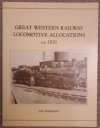Marc
It would be remiss of me not to refer you to my book on 1921 GWR Locomotive Allocations, published as long ago as 1984 by Wild Swan (and presumably long since out of print). I was subsequently responsible for a similar publication for 1934.

This gives the allocation by class of each locomotive at the start of 1921, and also lists the allocation at each shed on that date.
So for Cornwall, the allocations at each branchline shed were as follows:-
St Ives 4408 (44xx class)
Helston 1158 (517 class), 4403 (44xx)
Newquay 530 (517 class)
Moorswater 13 (unique 4-4-0ST), 1956 (19xx 0-6-0T)
Bodmin 2074, 2118 (2021 class 0-6-0T)
Launceston 4547 (45xx)
And at the "mainline" sheds:-
Penzance - 14 locos including 1 517 class, 1 850 class 0-6-0T, 1 Buffalo 0-6-0T, 1 44xx prairie and 10 tender locos (including a 26xx, a Duke, 2 43xx and 6 Bulldogs)
Truro - 20 locos including 2 517 class, 5 0-6-0 tanks, 1 steam railmotor and 12 tender locos (8 Dukes, 3 Bulldogs, 1 43xx)
St Blazey 25 locos including 17 0-6-0 tanks of various classes, 7 45xx prairies and 1 26xx.
The question you posed is of a general nature, so the above gives you a range of possibilities to choose, but I would caution that there is no such thing as a 'typical' branch line, in Cornwall or anywhere else.
There was to an extent to the logic behind the selection of a railway company of what locomotives to use on a particular line - governed by factors such as they type of traffic on offer, the ruling gradient of the line, etc. For example, St Blazey had lots of 0-6-0 tanks as it provided motive power for the area of clay extraction, while Helston and Newquay had 517 class 0-4-2 tanks which could deal with lightly loaded passenger trains. At this period it is unlikely that these trains were operated using autotrailers.
Another point to note is that the loco allocations changed over time, as older locomotives were withdrawn and newer ones introduced. It is notable that in 1921 the 45xx prairie tanks were almost all allocated to St Blazey, and presumably did mainly freight work. By the late 1920s futher batches of 45xx had been constructed and it is likely that they were also working at some of the branch line sheds, having replaced the 517 class locos.
Finally, of course, if it is a fictional branch line then it's your railway, so you can run what you choose!
Hope that helps,
Ian


